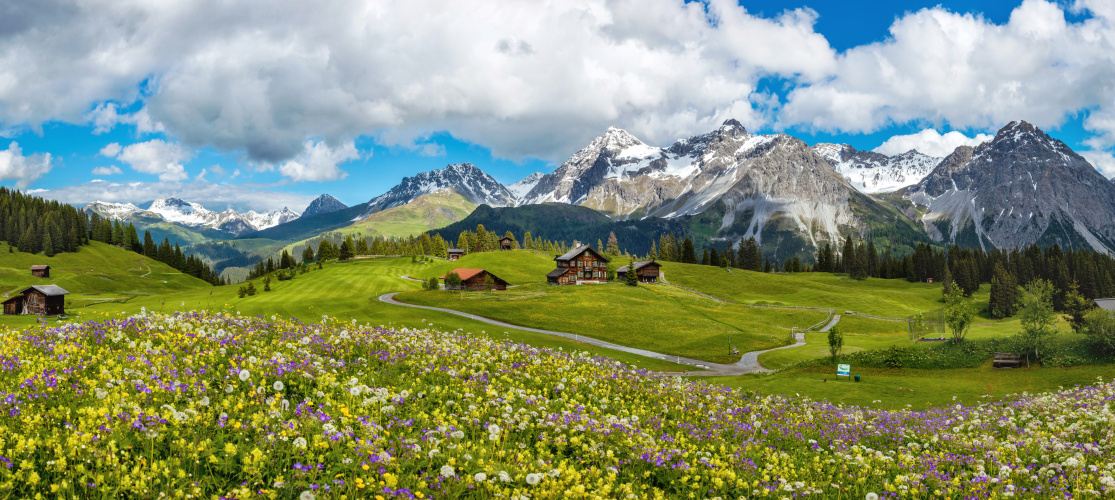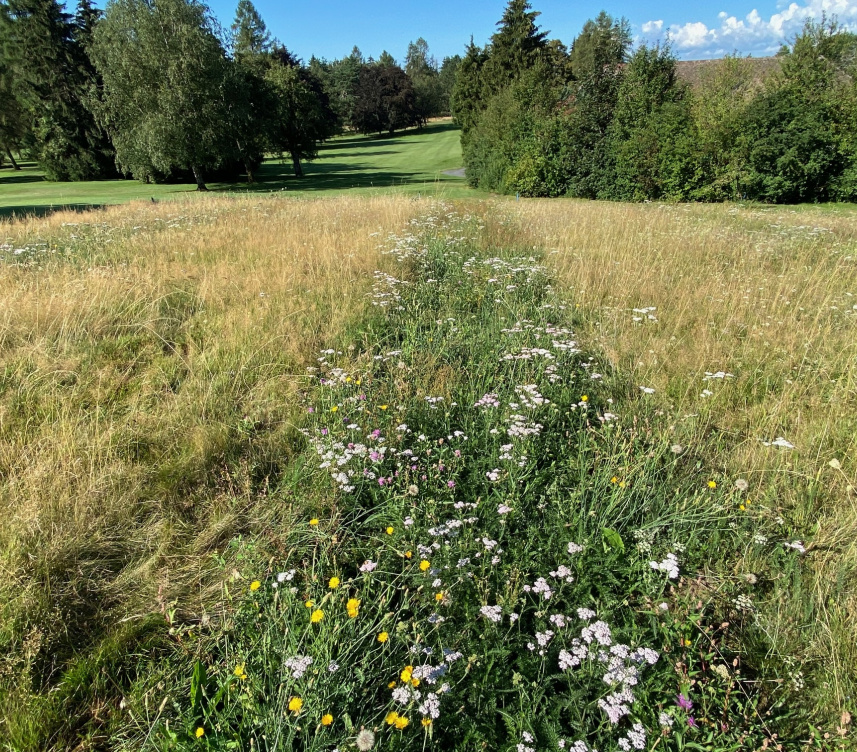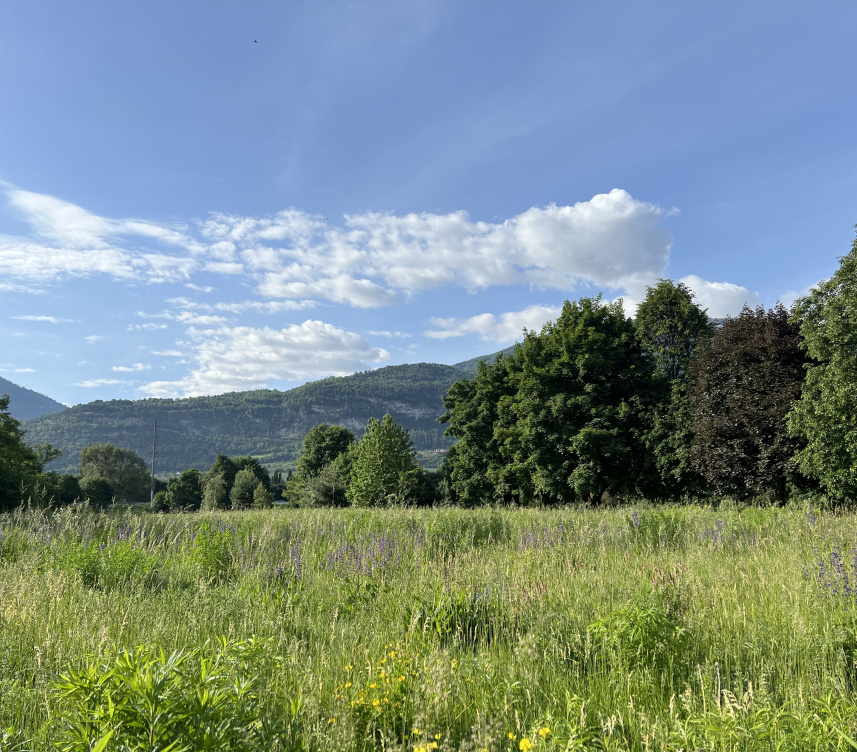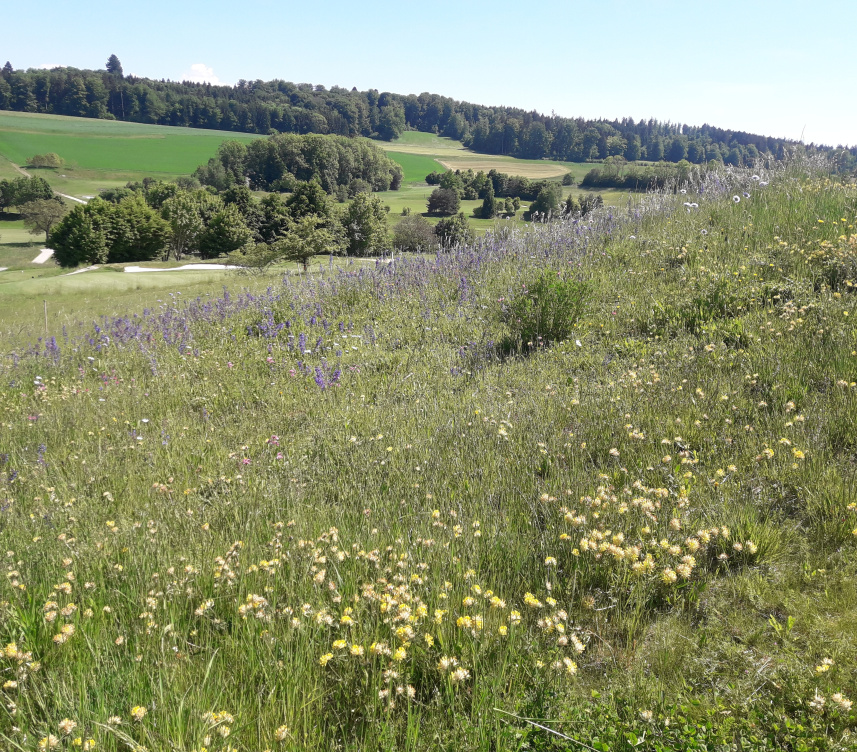

A Thriving Habitat: Case Studies of Protected Wild Areas on 4 Swiss Golf Courses
A thriving habitat
Natural prairies and extensive wild meadows contribute to the preservation of local flora and fauna. Selected examples of four certified Swiss golf facilities are presented.
Mirjam Fassold
The Golf Club of Lausanne has been addressing this theme in a targeted manner since 2007. At the time, the first natural and flowering meadows were “installed”. These 3.5 hectares of grassland have not received any fertilizer for fifteen years and are mowed (lately) only once a year. In 2014, the surface of the flower meadows was extended to 5 hectares, which represents approximately 10% of the total surface of the site.
The mowed grass is offered to a neighboring farmer to feed his cattle. Finally, in 2018, a change of use of the flower meadows of the Lausanne golf course followed; 2.7 hectares of these have been defined as “ecological protection zones” prohibited from access.
GOLF CLUB LAUSANNE, TO THE RIGHT OF TEE 7
In 2019, in collaboration with the Semences UFA technician, the inhabitants of Lausanne took a close look at their flowery meadows and their roughs. It was not only about biodiversity, but also about arranging the flora in a visually pleasing way on the golf course. “Wild meadows and extensively exploited roughs are not only a habitat for animals, but also for native plants,” explains Laurent Liatard, head greenkeeper.
Even if these surfaces require little maintenance, they must be looked at closely: “We must remain vigilant in controlling and eradicating invasive species. If these surfaces are well managed, native flowering species can flourish with the grasses present, which makes these surfaces visually interesting,” says Laurent Liatard.
In order to introduce more native wildflowers to the site, a flower meadow mix was strip-seeded in April 2020. These areas are to the right of green 1, to the right of tee 7, as well as to the right of green 15 and behind green 17. A first survey in August 2020 proved to be very satisfactory and showed that Greater Knapweed, Yarrow, Meadow Sage, Bugleherb, Wild Pansy, Biennial Crepitus, Bellflower, Wild Carrot, Flatweed, Field Knautie and Daisy, among others, have been successfully planted in the Golf of Lausanne.
GOLF CLUB SION, HOLE NO. 13
On the grounds of the Golf Club Sion, certified GEO in March 2022, there is only one flower meadow, but it covers an impressive area of 3000 square meters. Since 2018, it borders the fairway of 13 on its left side.
“In this meadow, there are around 50 species of plants per square meter,” explains Sébastien Paratte, director of the Club. “The composition of plants is special. It consists of native species, typical of Valais.” Maintenance work is limited to two cuts of hay per year, generally with a first cut at the mid-July, then a second in mid-September. And this is not only out of respect for the flowering period of the plants, which can thus reproduce, but also because the fauna benefits from it. “This meadow is home to foxes and squirrels, among other things,” adds Sébastien Paratte.
GOLF CLUB VUISSENS, TEE 18
As part of the GEO certification, also obtained in March 2022, the Golf Club Vuissens had a biodiversity assessment drawn up by a biologist. A site map was also produced. We now have very precise data which will make it possible to know whether animal and plant species have arrived on the golf course or whether they have disappeared.
1.45 hectares of extensive meadows on the course are operated by farmers and have been declared as areas for the promotion of biodiversity, in accordance with the Ordinance on Direct Payments. These meadows are favorable to butterflies, orthoptera, wild bees, spiders and other insects,” explains head greenkeeper Romain Lodieu. "We find on the golf course three species of endangered insects: the carpenter bee, the scabious moth (butterfly) and the meadow fritillary (butterfly)." In addition to these meadows, approximately 1 hectare of high rough area (photo) divided into small areas of 300 to 500 m2.
"They also have a particularly diverse flora," adds Romain Lodieu. Among the plant species present in these areas, we find bird's-foot trefoil, esparcette, European yellow-rattle, meadow salsify, sweet vernal grass, cuckoo's catchfly, creeping restharrow, daisy. The oldest flower meadows in the Vuissens golf course have existed for fifteen years, the most recent were sown in 2018. The meadows are mowed once a year, usually at the end of September/beginning of October. The hay is brought to a farmer in the village, where it is mixed with manure and spread on the fields as organic fertilizer.
GOLF CLUB AROSA, BETWEEN TEE 1 AND GREEN 9
The highest 18-hole course in Europe, that of Golf Club Arosa, offers a total of 10,000 square meters of flowery meadows. The largest contiguous meadow is between the first tee and the ninth green – “ever since” specifies the manager Livio Padrun. The term 'ever since' refers to the geographical location as the sequence of holes has changed since the expansion to 18 holes.
In this alpine terrain at nearly 2,000 meters above sea level, there are about ten species of plants per square meter, including martagon lilies, blue and yellow gentians, pulsatilla anemones, lupins, primroses, soldanella, arnica, heather and anemones. In the biotope between fairways 8 and 9 there are also marsh marigolds. The flower meadows of Arosa are mowed once a year, in August. “The hay is given to the sheep,” explains Livio Padrun. But before mowing, the flower meadows also serve as a habitat for many animals. Between the first tee and the ninth green, we have already seen wild bees, lizards, stoats, weasels, bumblebees, deer, hares, marmots, foxes, cuckoos "and in many rare cases, even chamois”, reveals the manager of the Golf of Arosa.



